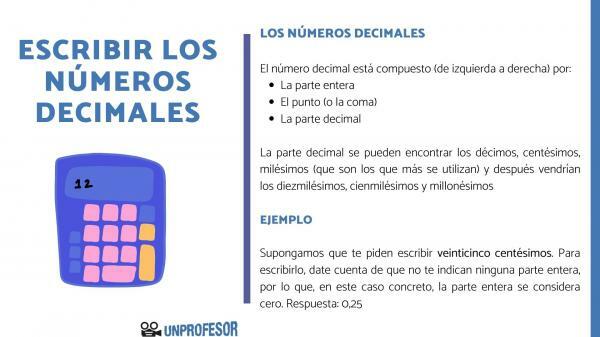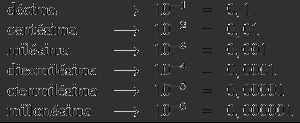How to write DECIMAL numbers

From a PROFESSOR, this time we bring you a topic that will serve you both in school lessons and for day-to-day life. In this case it is how to write decimal numbers. To do this, as is customary, we will begin with a brief definition about decimal numbers, and then enter fully into the topic of how to express decimals numerically. As support for this text you have the video of the lesson of our teacher Cristina Álvarez, and of course, we will provide you with some examples of what was explained in class.
Index
- What is a decimal number
- How to write decimal numbers (with video and examples)
- Examples of how to write decimal numbers
- Exercises for writing decimal numbers
- Solution of decimal numbers exercises (with table)
What is a decimal number.
The decimal numbers They are used to represent a number that is made up of a whole part and a decimal part; that is, a number that contains a part that is not an integer. However, it must be said that there are decimal numbers that do not contain a whole part, since they are less than 1. For example the 0.25 of a decimal number that does not have an integer part.
Also, as you can see in the previous example, decimal numbers have a point (in some cases a comma, which is equally valid). This point separates the integer part from the decimal part. This is how to the left of the apostrophe you will find the integer part and to the right, the decimal part.
How to write decimal numbers (with video and examples)
Having said the above, in this section of the lesson, we are going to explain how decimal numbers are written; that is, the objective of this class, as indicated by Professor Cristina in the video, is that you can transcribe or pass the figures written in numerical figures. For this we are going to give you a brief theoretical explanation, we are going to represent it in a table and then we will do some exercises for you to practice.
As you know, the decimal number is composed (from left to right) for the whole part, then the period (or comma) and the decimal part.
In this decimal part you can find the tenths, hundredths, thousandths (which are the most used) and then the ten thousandths, hundredths and millionths would come; These last three are not very common, but we also add them so that you take it into account and the lesson is more complete.
Examples of how to write decimal numbers.
To continue the explanation and know how to write decimal numbers, we are going to present you some examples and At the end of each one there will be a table where the answers are so you can see the results with greater clarity. Let's get started.
- Example A: Suppose you are asked to write twenty-five hundredths. To write it, note that they do not indicate any integer part, so, in this specific case, the integer part is considered zero. Answer: 0.25
- Example B: Imagine that you are asked to write the number thirteen integers four tenths. In this case, they do tell you what the integer part is, followed by the decimal part. So the result is: 13.4.
- Example C: They ask you to write two integers three hundred seventy-three thousandths. In this exercise they also show you the integer part of the decimal number. Therefore, the result would be 2,373.
We leave you one table with the results of the examples so that you can more easily see the conformation of the decimal numbers.
This table, as Professor Cristina has done, is very useful for locating decimals when you have not had much practice with decimal numbers. Therefore, we advise you to lean on it at the beginning so that you can get practice and then you will do it more easily.

Exercises to write decimal numbers.
To continue practicing we leave you some training with the explanation and respective results.
- 37 thousandths
- 25 integers, 32 hundredths
- 7 integers, 115 thousandths
- 2 integers, 1525 ten thousandths
- 125 thousandths
- 20 integers, 32 hundredths
Reminder: You can make a larger table when they ask for ten thousandths, hundred thousandths and millionths. What you should do is add one more box for each decimal, and of course, add another digit to the decimal part of the number.
Solution of decimal numbers exercises (with table)
Here we leave you the solution of the exercises that we have proposed in the previous section so that you can check your results:
- 0.037
- 25.32
- 7.115
- 2.1525
- 0.125
- 20.32
Note: Remember that you must match the number that they indicate to you with the corresponding decimal and if they do not tell you the whole number, fill in the table with a 0 in that box.
As always, from a Teacher, we hope this lesson has been helpful to you and we encourage you to continue studying and practicing with exercises. For any other questions, about this or other related topics, do not hesitate to consult our website.

If you want to read more articles similar to Write the decimal numbers, we recommend that you enter our category of Arithmetic.



